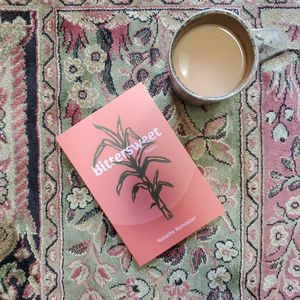The Writing Moment with Natasha Ramoutar's Bittersweet
By Daniel Scott Tysdal
Welcome to “The Writing Moment with . . .”!
In this series of craft-focused columns, I will explore a wide range of works, topics, and interests that inspire me with the hope of inspiring you. I will discuss what moves me in these different creations and practices, highlighting the spurs, lessons, and reminders that can serve as prompts and openings into creative possibility.
I call this column “The Writing Moment” because of the helpful double meaning of moment. Each of these individual prompts should only take a moment, and, I hope, each will inspire you to “have a moment,” sparking a burst of creative exploration—even on the busiest, or most reluctant, day.
Without further ado, then, let’s get right into our first column, “The Writing Moment … with Natasha Ramoutar’s Bittersweet!”
Natasha Ramoutar’s debut poetry collection, Bittersweet, was published by Mawenzi House in the fall off 2020. This semester, I had the great joy of teaching Bittersweet in ENGC09: Canadian Poetry at the University of Toronto Scarborough. There are many features I value about this classroom experience.
I loved the opportunity to teach such an honest, immersive, and illuminating meditation on, and searching journey through, the South Asian diasporic experience. Students who share this history or histories like it were given a fertile mirror in which to see and discover themselves. They were energized, illuminating the work through their distinct understandings and providing new perspectives. Those, like me, who do not share this history, were offered a rich, welcoming education and the chance to discuss what we learned through our listening.
I was also grateful for the opportunity to teach such an accomplished and multi-faceted collection of poems. We considered the different ways Ramoutar’s collection wove together a variety of traditions and threads of Canadian poetry, while, at the same time, breaking new ground. Ramoutar’s many poetic gifts also invited us to discuss the inner-workings and effects of a wide range of poetic tools and techniques.
However, because ENGC09 is an academic class, we couldn’t significantly dive into Bittersweet as a catalyst for creative writing—hence, my desire to pen this column. I really wanted to distill some of the many ways Ramoutar’s poetry helps us hone our craft and generate new work, whether we write poetry, fiction, non-fiction, comics, or scripts.
Here are a few writing moments I am excited to explore in my own writing and to bring into future classrooms:
Your CanLit News
Subscribe to Open Book’s newsletter to get local book events, literary content, writing tips, and more in your inbox
1) Poem/Story Seeds:
Whenever I read a book, watch a movie, or take in an art exhibition, I keep my eye (or, really, senses and spirt) out for poem/story seeds. These are lines or images that, for varying reasons, are loaded with energy and significance. Even in the first encounter, I can feel them generating something in me.
I save these seeds for when I am stuck. This may occur when I have time to start new work, but nothing is coming. I may also turn to these seeds when I am struggling to finish a poem or a story or script. In the context of fiction, the seed can serve as a point of conflict, connection, or epiphany.
Ramoutar’s collection is filled with these seeds. Here’s a pair to explore through yourself or characters:
- “Could we speak about joy for once?” (45)
- “always digging / up graves to watch ghosts of past selves” (64)
2) Temperature Connection:
Sense-memory immersion exercises provide the opportunity to practice composing with imagery, to make personal discoveries, and to generate new work. Most teachers I’ve studied with utilize multiple variations of this exercise, and I encountered my favourite—and the most thorough—example in Lynda Barry’s What It Is.
I am always on the lookout for poems that provide specific variations on this exercise. Ramoutar’s “Swell” (38) is a fertile example. Returning to Guyana, the speaker’s mother “swells from the sweltering heat”; the speaker then develops this embodied heat imagery to speculate upon the potential for a homeland to “forget” someone who called it home.
Here is a sense-memory immersion exercise prompted by this poem, which you could undertake yourself or through the memories of one of your characters:
- Immerse yourself in a memory associated with an extreme temperature or harsh weather.
- Spend time remembering this moment. Explore this memory through all of your senses.
- Return to an experience of connection or division that defined your life at that time.
- Write about this experience of connection or division through your sensory experience of the extreme temperature or harsh weather. Write about this temperature or weather through this connection or division.
3) Person-art-fication:
Ramoutar’s poem “198” holds a special place in my heart for two reasons. First, the 198 in the title is a TTC bus I rode 6-10 times a week for four years during the teaching term until the route was discontinued in 2018. Second, the subject in the poem who waits for the bus, a bus that never arrives, is a personified poem. Oh, this speaks to me on so many levels.
(Actually, as I break to reread “198” again, I realize I need to note the third and most important reason I love this poem: the truly marvelous work Ramoutar does with this meeting of living art and lived routine.)
Here are two possible ways you might go about creating your own example of person-art-fication:
- Write about a personified work of literature or art (whether a novel, painting, or an NFT jpg) going through a specific routine or series of routines from your day (or the day of the one of your characters).
- Write about a personified work of art doing something extraordinary, whether travelling to Mars, dispensing vaccines to all, or explaining what exactly an “NFT jpg” is.
4) “fish hooked fingers” / “below the skipping”:
This one is less a writing prompt, and more of a prompt to reflect as you read, write, and revise.
There are a number of poems in Bittersweet I returned to again and again because I found myself at once devastated and enrapt, yet unable to fully account for how or why. “Tracer” (10) and “Rock Bottom” (25), the poems I quoted in the title of this section, are the two I returned to the most.
One feature that really stood out to me as I reread these poems was Ramoutar’s work with directionality and verbs—the dynamic way she “moved” us spatially and temporally and the distinct yet apt verbs she used to create this movement. These are elements to tend to in our poems, but also in our prose works, whether through how we construct a setting in a script or the structure of the impassioned speech our protagonist delivers to sway another character.
I would also recommend reading Ramoutar’s triptych of “Time” poems for another stimulating example of this work, both the poems individually and for how they interact with one another, sprinkled out of order (or are they?) throughout the collection.
5) I’ll Have the Hybrid:
At TIFF 2017, I saw what remains one of my all-time favourite short films, Robin Comisar’s Great Choice. The IMDB description sort of says it all: “A woman gets stuck in a Red Lobster commercial.” In creating a film that is part-horror film, part-looped 80s commercial, Comisar renews the horror genre and tells a unique—and, in the end, moving—story of personal resilience.
Bittersweet contains a number of artful hybrid poems, works that are part-poem and, respectively, part-definition, part-manual, part-recipe, part-online map instructions, and part-vacation itinerary. The power of Ramoutar’s hybrids arises both from how they renew poetry and how they reflect back upon the form she borrows, revealing it and the experience it shapes in a new light.
Here is one way to go about creating your own hybrid works:
- Choose a non-literary form of documentation you have a significant connection to or deep revulsion for. (You may also undertake from the perspective of one of your characters.)
- Write about this connection or revulsion through the conventions, layouts, jargon, etc. associated with this form of documentation.
- Alternately, write about an experience or feeling that has nothing to do with the form, but could come to life through it in a surprising way.
6) Sub-Subtext:
In Ramoutar’s “Ink” (18), the speaker dramatizes an argument with her sister. She provides both what they “tell” one another and, beneath this, what they “don’t tell,” as a way of delving into hidden motivations and undiscussed histories. The effect of this technique is to reveal the conversations we really have when we have a conversation.
“Ink” ends with a provocative turn: the speaker provides a “don’t tell” with no companion “tell.” This foregrounds the silences that inevitably remain, and reflects back on the rest of the poem, suggesting that beneath all that is unspoken resides more unspoken, roils the unspeakable.
Here are three possible ways to try out this technique:
- Follow Ramoutar’s lead and write an exchange in which you provide both what your characters “tell” and what they “don’t tell.” You may compose this based on a real conversation or invent a new one entirely.
- You can also use this approach as a revision technique. Return to a dialogue you have already completed and write out the “don’t tell” for each “tell.” This can help you revise your dialogue in terms of subject, motivation, and rhythm of concealing/revealing.
- On a more speculative note, what happens if you try to get right to the sub-subtext? Dive as deeply as you can into the unspoken and unspeakable and write what you find there, whether it is horrifying, absurd, or completely illegible.
7) Following Order’s Orders:
One question poets and short story writers all struggle with is: what is the order of my collection? Which story follows which story? Which poem comes after which poem?
Bittersweet is a collection well worth studying on this front. Each individual poem stands on its own, yet, at the same time, Ramoutar develops a larger arc of history, discovery, and transformation that ties the collection together. She also orders the poems in such a way that they interact with one another. I was viewing this as pairings, but, during our class discussion, one student observed that these groupings often manifested in sets of three.
I foreground this not to offer a cookie cutter model, but to propose an example worth careful thought and because our class discussion of Ramoutar’s work with order spurred this final prompt:
- Grab a collection of poems (preferably Bittersweet) or stories you have recently read.
- Return to a poem or story that really stuck with you. Write a response to this poem or story by writing the poem or story that could follow it in the collection.
The views expressed by Open Book columnists are those held by the authors and do not necessarily reflect the views of Open Book.
Daniel Scott Tysdal is the ReLit Award-winning author of three books of poetry, the poetry textbook The Writing Moment: A Practical Guide to Creating Poems, and the TEDx talk, “Everything You Need to Write a Poem (and How It Can Save a Life).” His short films have screened at festivals in Canada, the US, Mexico, and Australia, and his debut short story collection, Wave Forms and Doom Scrolls, is forthcoming from Wolsak & Wynn. He teaches at the University of Toronto Scarborough.





